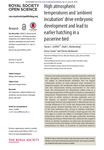Please use this identifier to cite or link to this item:
http://lib.hpu.edu.vn/handle/123456789/21690Full metadata record
| DC Field | Value | Language |
|---|---|---|
| dc.contributor.author | Griffith, Simon C. | en_US |
| dc.date.accessioned | 2016-06-25T01:57:05Z | |
| dc.date.available | 2016-06-25T01:57:05Z | |
| dc.date.issued | 2016 | en_US |
| dc.identifier.other | HPU4160309 | en_US |
| dc.identifier.uri | https://lib.hpu.edu.vn/handle/123456789/21690 | en_US |
| dc.description.abstract | Tropical and subtropical species typically experience relatively high atmospheric temperatures during reproduction, and are subject to climate-related challenges that are largely unexplored, relative to more extensive work conducted in temperate regions. We studied the effects of high atmospheric and nest temperatures during reproduction in the zebra finch. | en_US |
| dc.format.extent | 14 p. | en_US |
| dc.format.mimetype | application/pdf | en_US |
| dc.language.iso | en | en_US |
| dc.publisher | The Royal Society | en_US |
| dc.subject | Biology | en_US |
| dc.subject | Behaviour | en_US |
| dc.subject | Ecology | en_US |
| dc.subject | Evolution | en_US |
| dc.subject | Architecture | en_US |
| dc.subject | Taeniopygia | en_US |
| dc.subject | Guttata | en_US |
| dc.title | High atmospheric temperatures and ‘ambient incubation’ drive embryonic development and lead to earlier hatching in a passerine bird | en_US |
| dc.type | Book | en_US |
| dc.size | 734KB | en_US |
| dc.department | Education | en_US |
| Appears in Collections: | Education | |
Files in This Item:
| File | Description | Size | Format | |
|---|---|---|---|---|
| 0192_Highatmospherictemperatures.pdf Restricted Access | 734.6 kB | Adobe PDF |  View/Open Request a copy |
Items in DSpace are protected by copyright, with all rights reserved, unless otherwise indicated.
